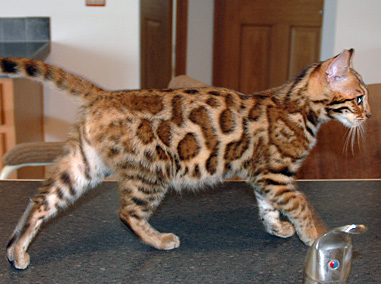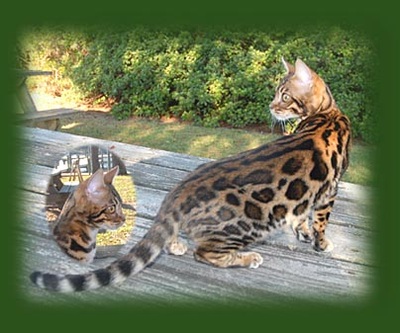About Bengal History
The Bengal cat breed has a history that dates back to 1963. The Bengal breed is developed through the crossing of an Asian Leopard Cat with a domestic breed. The crossing of the two breeds brings about an exotic, "wild cat" look to a domesticated house cat. Though the crossing of a wild breed with a domestic breed can be traced back many years prior to the 1960s, the Bengal breed's official origins began in 1963. Breeder Jean Mill, of Covina, California had an Asian Leopard Cat as a pet, and decided to provide a companion for it.
The companion was a domestic cat and, the two surprisingly produced a litter in 1965. Typically, breeding a domestic and wild cat produces offspring that are infertile, but this litter produced fertile female offspring. One of the female offspring, Kin-Kin was later mated with her father, and produced two offspring. Jean Mill had to abandon the breeding of wild and domestic cats when she was suddenly widowed in 1965. And thus, the beginning of the Bengal breed had to be sidelined as Ms. Mill was no longer able to take on the project. But, in 1973, a geneticist named Dr. Willard Centerwell began to breed wild and domestic cats because he was interested in studying feline leukemia. Research was showing that Asian Leopard Cats were resistant to feline leukemia.
After the study was completed, Dr. Centerwell gave some of his kittens to Jean Mill in 1980, after remarrying, and Jean Mill began to breed Bengal cats again. Mill had the females needed for breeding from Dr. Centerwell and began a search for suitable males. One male, an orange short haired domestic cat, traveled all the way from India to be bred. The other male bred with the females Mill had was a spotted brown tabby that Mill had found in a local shelter. It took many generations of breeding to get the Bengal cat that we know today. Generations into breeding now produces sweet tempered, more predictable breeds that are more suitable for living with people. While Jean Mill and Dr. Centerwell were fascinated with the idea of breeding wild and domestic cats.
The companion was a domestic cat and, the two surprisingly produced a litter in 1965. Typically, breeding a domestic and wild cat produces offspring that are infertile, but this litter produced fertile female offspring. One of the female offspring, Kin-Kin was later mated with her father, and produced two offspring. Jean Mill had to abandon the breeding of wild and domestic cats when she was suddenly widowed in 1965. And thus, the beginning of the Bengal breed had to be sidelined as Ms. Mill was no longer able to take on the project. But, in 1973, a geneticist named Dr. Willard Centerwell began to breed wild and domestic cats because he was interested in studying feline leukemia. Research was showing that Asian Leopard Cats were resistant to feline leukemia.
After the study was completed, Dr. Centerwell gave some of his kittens to Jean Mill in 1980, after remarrying, and Jean Mill began to breed Bengal cats again. Mill had the females needed for breeding from Dr. Centerwell and began a search for suitable males. One male, an orange short haired domestic cat, traveled all the way from India to be bred. The other male bred with the females Mill had was a spotted brown tabby that Mill had found in a local shelter. It took many generations of breeding to get the Bengal cat that we know today. Generations into breeding now produces sweet tempered, more predictable breeds that are more suitable for living with people. While Jean Mill and Dr. Centerwell were fascinated with the idea of breeding wild and domestic cats.
My Cazpurr pictures of Cats shown below




















